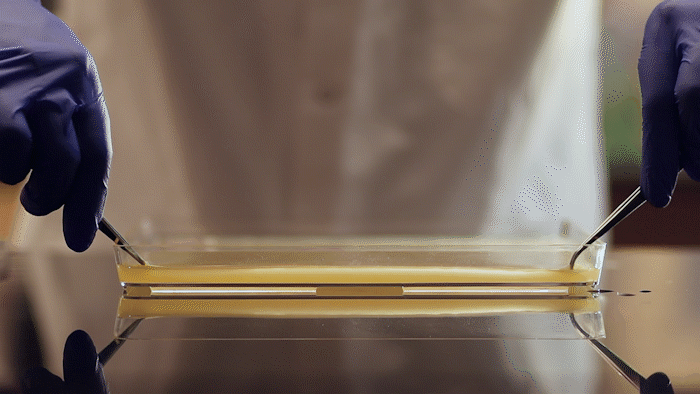
This mixture, also known as SCOBY (symbiotic culture of bacteria and yeast), was used by the researchers to produce cellulose embedded with enzymes that can perform functions such as sensing environmental pollutants. They also showed that they could incorporate yeast directly into the material, creating "living materials" that could be used to purify water or to make "smart" packaging materials that can detect damage by using fluorescence.
CLICK FOR MORE ON MATERIALS IN THE ENGINEER
"We foresee a future where diverse materials could be grown at home or in local production facilities, using biology rather than resource-intensive centralised manufacturing," said Timothy Lu, an MIT associate professor of electrical engineering and computer science and of biological engineering.
Lu and Tom Ellis, a professor of bioengineering at Imperial College London, are the senior authors of a paper detailing their work in Nature Materials. The paper's lead authors are MIT graduate student Tzu-Chieh Tang and Cambridge University postdoc Charlie Gilbert.
Lu's lab had previously developed a way to use E. coli to generate biofilms embedded with materials such as gold nanowires. Those films are very small and thin, making them difficult to use in most large-scale applications. In the new study, the researchers set out to find a way to improve scalability.
They thought of creating a microbe population similar to a kombucha mother, which is a mixture of certain types of bacteria and yeast that gives kombucha tea its distinctive flavour.
Most of the wild yeast strains used for fermentation are difficult to genetically modify, so the researchers replaced them with Saccharomyces cerevisiae, which is a strain of laboratory yeast.
They combined the yeast Komagataeibacter rhaeticus, which their collaborators at Imperial College London had previously isolated from a kombucha mother and can produce large quantities of cellulose.
According to MIT, cells in a laboratory strain of yeast can be engineered to produce enzymes that glow in the dark, or sense pollutants in the environment. The yeast can also be programmed so that they can break down pollutants after detecting them.
The bacteria in the culture produce large-scale quantities of cellulose to serve as a scaffold. The researchers designed their system so that they can control whether the yeast themselves, or just the enzymes that they produce, are incorporated into the cellulose structure. The material can be grown in few days and can eventually thicken enough to occupy a space as large as a bathtub.
"We think this is a good system that is very cheap and very easy to make in very large quantities," Tang said in a statement. "It's at least a thousand times more material than the E.coli system."
To demonstrate the potential of their microbe culture, which they call Syn-SCOBY, the researchers created a material incorporating yeast that senses estradiol, which is sometimes found as an environmental pollutant. In another version, they used a strain of yeast that produces a glowing protein (luciferase) when exposed to blue light. These yeasts could be swapped out for other strains that detect other pollutants, metals, or pathogens.
The culture can be grown in normal yeast culture medium, which the researchers used for most of their studies, but they have also shown that it can grow in tea with sugar. The researchers foresee that the cultures could be customised for people to use at home for growing water filters or other useful materials.
"Pretty much everyone can do this in their kitchen or at home," Tang said. "You don't have to be an expert. You just need sugar, you need tea to provide the nutrients, and you need a piece of Syn-SCOBY mother."





Poll: Should the UK’s railways be renationalised?
The term innovation is bandied about in relation to rail almost as a mantra. Everything has to be innovative. There is precious little evidence of...